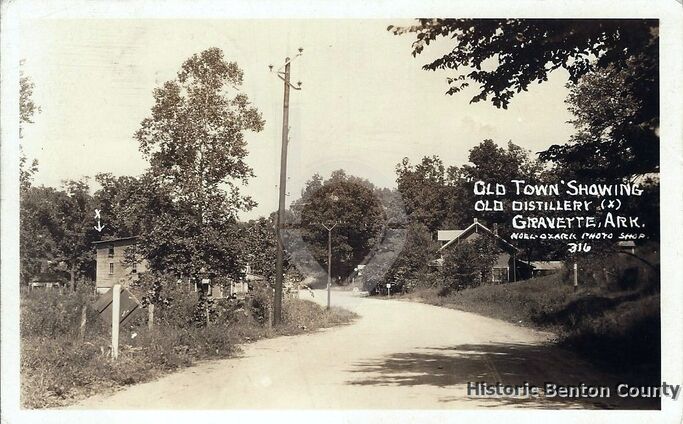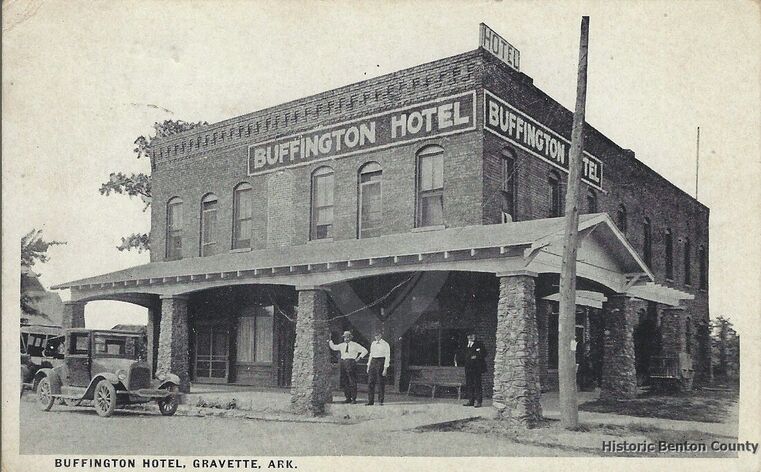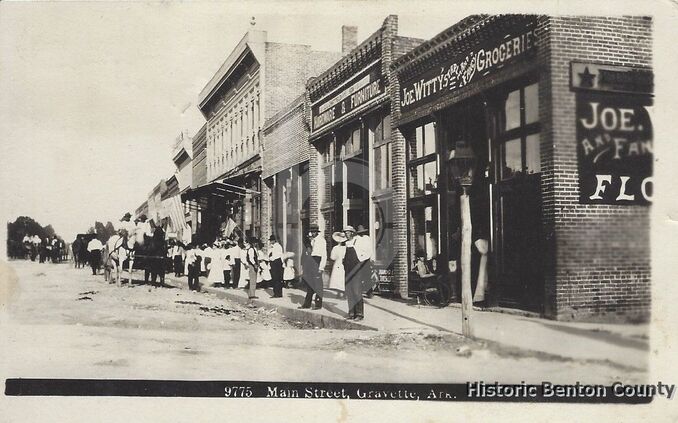From Nebo - To a Land of Promise (Gravette)
By Lela Wiggin Givens - published on September 1, 1963, likely in the Gravette News Herald
By Lela Wiggin Givens - published on September 1, 1963, likely in the Gravette News Herald
Ed Gravett mounted the hill above Nebo, his home in Chalk Valley. and viewed the land about him. Like Moses, of old, he saw promise in this new land, but, unike Moses, Ed was allowed to enter this new world and to fulfil his dream.
On Aug. 9, 1893, Ed, a Nebo merchant, opened the first general store on the new site. He was later honored by the town being named for him.
Hugh Fair, the eldest living charter citizen from Nebo days, proudly recalls: "I was there, one of the first to enter the store on its grand opening. Of course I was just a small tyke of 9 or 10," he furthered, "but I remember it well."
This first store was located on what is now the extreme east end of Gravette's present business district. Other merchants followed Ed, and soon Nebo was almost entirely divested of its shops.
Many residences remain in Chalk Valley. Among these is a two-story house which belongs, as does most of the valley's land, to Fred and Sue Stumbo. The house, built in 1923, replaces one formerly owned by the "Covey's." Many old-timers still stop at the Stumbo home and drink from a "never-failing" spring which was Nebo's chief water source.
Gravette of today is an up and coming little city of nearly 1,000 persons. Its business places, if laid end to end would stretch more than a mile, but, in its compact way, most stores are within easy walking distance of your parked car.
On Aug. 9, 1893, Ed, a Nebo merchant, opened the first general store on the new site. He was later honored by the town being named for him.
Hugh Fair, the eldest living charter citizen from Nebo days, proudly recalls: "I was there, one of the first to enter the store on its grand opening. Of course I was just a small tyke of 9 or 10," he furthered, "but I remember it well."
This first store was located on what is now the extreme east end of Gravette's present business district. Other merchants followed Ed, and soon Nebo was almost entirely divested of its shops.
Many residences remain in Chalk Valley. Among these is a two-story house which belongs, as does most of the valley's land, to Fred and Sue Stumbo. The house, built in 1923, replaces one formerly owned by the "Covey's." Many old-timers still stop at the Stumbo home and drink from a "never-failing" spring which was Nebo's chief water source.
Gravette of today is an up and coming little city of nearly 1,000 persons. Its business places, if laid end to end would stretch more than a mile, but, in its compact way, most stores are within easy walking distance of your parked car.
This image shows part of what was Nebo, also known as Chalk Valley.
The arrow on the left side of the image points to where the old distillery was located.
The arrow on the left side of the image points to where the old distillery was located.
Church goers have a choice of ten different churches to choose from in Gravette. In the Gravette Medical Center, the town has an up-to-date hospital. Br. Billy V. Hall, fresh out of medical school, came to Gravette in June of 1951 and resolved to build a hospital in the town in 10 years.
It took him less than half the alloted time to open his 12-room hospital. Today contractors are well on their way toward the hospital's third major addition. The completed structure will be twice its present size and will serve a radius of 20 miles.
A new $200,000 high school will welcome students this fall. If J. E. Garrett, high school principal of 1893, could be present at the new school's first enrollment this fall, he would note a 300-pupil gain over his 40 students.
Also included in the recent building program was a new Assembly of God church, a new super-market, and numerous new homes.
Were it possible for A. C. Beach, the News Herald's first publisher, to view the numerous construction jobs underway in Gravette today, he might recall one of his favorite expressions of the [18]90s:
"The sound of hammer and saw is heard early and late." He thus described the bustling building activity of his day. It appears now that the bulldozer, backhoe, and redi-mix cement trucks have supplanted those former sounds of hammer and saw.
In the summer of '51 I found myself a widow with seven minor children and a farm on my hands. Selling the farm I had to decide where to locate. I chose Gravette, in preference to neighboring Missouri towns, for one reason - the absence of taverns. I did not want my children to have to pass a "smelly" saloon every time they walked down main street.
Gravette, nestled in the heart of the Ozarks, is the black walnut capital of the nation. Much progress has been made since the company's beginning in 1963. Its initial annual payroll was approximately $1,300; last year's payroll reached nearly $1 million. Last season, from a seven-state area, over $400,000 worth of walnuts were bought. Most of this amount was paid to farm persons who gathered the walnuts.
The new power-huller has revolutionized the walnut processing industry. Thus huller, or hullers, designed and made, as is most of the machinery used in the plant's operation. by local labor, has saved the walnut gatherers hours of hard, tedious work. During the peak months about 160 person are employed by the shelling company.
An aid to the farmers is Gravette's seed processing plant. This plant enables the farmer to utiilize his own seeds, and supplies an outlet for his surplus.
The large brick stucture, known as the Buffington Hotel, thanks to Mr. and Mrs. Young, is still in use today. The Young's purchased the badly dilapidated building; renovated and made it into an apartment house. This quaint dwelling carries with it quite a legend.
Thomas Richard Keith, a hardware dealer in Maysville Ark., decided to move a short distance south and start a city of his own which he called "Rome City." Here he built a brick structure in which he operated a hardware store for a number of years. With the birth of Gravette and the coming of the railroad. Thomas saw a more promising location. So, brick by brick, he moved his building to this promising new town. His new structure, when erected, became known as the "Buffington" Hotel.
It took him less than half the alloted time to open his 12-room hospital. Today contractors are well on their way toward the hospital's third major addition. The completed structure will be twice its present size and will serve a radius of 20 miles.
A new $200,000 high school will welcome students this fall. If J. E. Garrett, high school principal of 1893, could be present at the new school's first enrollment this fall, he would note a 300-pupil gain over his 40 students.
Also included in the recent building program was a new Assembly of God church, a new super-market, and numerous new homes.
Were it possible for A. C. Beach, the News Herald's first publisher, to view the numerous construction jobs underway in Gravette today, he might recall one of his favorite expressions of the [18]90s:
"The sound of hammer and saw is heard early and late." He thus described the bustling building activity of his day. It appears now that the bulldozer, backhoe, and redi-mix cement trucks have supplanted those former sounds of hammer and saw.
In the summer of '51 I found myself a widow with seven minor children and a farm on my hands. Selling the farm I had to decide where to locate. I chose Gravette, in preference to neighboring Missouri towns, for one reason - the absence of taverns. I did not want my children to have to pass a "smelly" saloon every time they walked down main street.
Gravette, nestled in the heart of the Ozarks, is the black walnut capital of the nation. Much progress has been made since the company's beginning in 1963. Its initial annual payroll was approximately $1,300; last year's payroll reached nearly $1 million. Last season, from a seven-state area, over $400,000 worth of walnuts were bought. Most of this amount was paid to farm persons who gathered the walnuts.
The new power-huller has revolutionized the walnut processing industry. Thus huller, or hullers, designed and made, as is most of the machinery used in the plant's operation. by local labor, has saved the walnut gatherers hours of hard, tedious work. During the peak months about 160 person are employed by the shelling company.
An aid to the farmers is Gravette's seed processing plant. This plant enables the farmer to utiilize his own seeds, and supplies an outlet for his surplus.
The large brick stucture, known as the Buffington Hotel, thanks to Mr. and Mrs. Young, is still in use today. The Young's purchased the badly dilapidated building; renovated and made it into an apartment house. This quaint dwelling carries with it quite a legend.
Thomas Richard Keith, a hardware dealer in Maysville Ark., decided to move a short distance south and start a city of his own which he called "Rome City." Here he built a brick structure in which he operated a hardware store for a number of years. With the birth of Gravette and the coming of the railroad. Thomas saw a more promising location. So, brick by brick, he moved his building to this promising new town. His new structure, when erected, became known as the "Buffington" Hotel.
The Buffington Hotel was originally located in the little town of Rome City. The building was moved brick by brick in 1890 to its new location in Gravette.
Two of Nebo's first settlers were Henry Austin and his mother, Ellen, who settled there in 1845. Nebo was so dubbed by a jokester noting the contrast between its location and that of high Mount Nebo from whence Moses viewed the promised land.
Two brothers, John Nap Covey and Welcome Boy Covey, moved their families to the Nebo community in the early [18]60s. J. D., son of John Nap, was born in Nebo in 1863. He attended neighboring schools and later the Southwest Academy in Southwest City, Mo. Finishing his schooling, he returned and taught his home school.
Welcome Boy, a minister of the Christian Church, later performed his nephew's wedding ceremony. In 1886, A.D. was elected justice of the peace of Nebo and appointed postmaster. He also operated a small general store in which was located the post office with mail being brought from Bentonville by horseback.
Among Nebo's places of businesses were a hotel, flour mill and a distillery.
A building for the storage of the kegged whisky (which incidentally still stands) set high off the ground. One night someone crawled under the building and, with the aid of a brace and bit, bored a hole through the floor and directly into one of the filled kegs. The liquor flowed freely, quickly filling the man's three or four gallon jugs. There was nothing left but for the remainer to run out onto the ground.
Years later the culprit was converted and became a preacher. In wishing to make restitution, he confessed to the deed.
The order of the Eastern Star No. 95 was chartered in Chalk Valley in 1890. Hugh Fair's mother was first worthy matron. According to news reports of 1898. It was stated that nearly all secret societies were well represented.
Juvenile delinquency is not new in Gravette as some may be led to believe. As early as 1902 we have an account of a juvenile escapade. Many local cows turned up minus tails. Investigating authorities found that a transient merry-go-round operator had offered the boys free rides in exchange for fresh cow's tails to refurbish his shabby wooden horses' tails. The account does not disclose if the operator was punished but it did state that the boys and their fathers had an interesting sessions in the woodshed.
Two brothers, John Nap Covey and Welcome Boy Covey, moved their families to the Nebo community in the early [18]60s. J. D., son of John Nap, was born in Nebo in 1863. He attended neighboring schools and later the Southwest Academy in Southwest City, Mo. Finishing his schooling, he returned and taught his home school.
Welcome Boy, a minister of the Christian Church, later performed his nephew's wedding ceremony. In 1886, A.D. was elected justice of the peace of Nebo and appointed postmaster. He also operated a small general store in which was located the post office with mail being brought from Bentonville by horseback.
Among Nebo's places of businesses were a hotel, flour mill and a distillery.
A building for the storage of the kegged whisky (which incidentally still stands) set high off the ground. One night someone crawled under the building and, with the aid of a brace and bit, bored a hole through the floor and directly into one of the filled kegs. The liquor flowed freely, quickly filling the man's three or four gallon jugs. There was nothing left but for the remainer to run out onto the ground.
Years later the culprit was converted and became a preacher. In wishing to make restitution, he confessed to the deed.
The order of the Eastern Star No. 95 was chartered in Chalk Valley in 1890. Hugh Fair's mother was first worthy matron. According to news reports of 1898. It was stated that nearly all secret societies were well represented.
Juvenile delinquency is not new in Gravette as some may be led to believe. As early as 1902 we have an account of a juvenile escapade. Many local cows turned up minus tails. Investigating authorities found that a transient merry-go-round operator had offered the boys free rides in exchange for fresh cow's tails to refurbish his shabby wooden horses' tails. The account does not disclose if the operator was punished but it did state that the boys and their fathers had an interesting sessions in the woodshed.
A view of Gravette from the early 1900s
Possibly now when a father punishes his son for an act of delinquency, the youngster may be likely to ask, "Dad, were you one of the lads who cut off the cows tails? Or maybe it was Grandad!"
A dug well, located just north of Main Street, furnished the town's water supply. It was also used for watering the horses that were tied at the hitching rack, which, oddly enough, was located where a service station now furnishes go-power for our horseless buggies.
J.W. McAllister built the town's first hotel in 1898. It burned in 1901 along with most of the business houses. About three such disasters, an ordinance was passed banning the construction of frame business establishments.
A dug well, located just north of Main Street, furnished the town's water supply. It was also used for watering the horses that were tied at the hitching rack, which, oddly enough, was located where a service station now furnishes go-power for our horseless buggies.
J.W. McAllister built the town's first hotel in 1898. It burned in 1901 along with most of the business houses. About three such disasters, an ordinance was passed banning the construction of frame business establishments.



